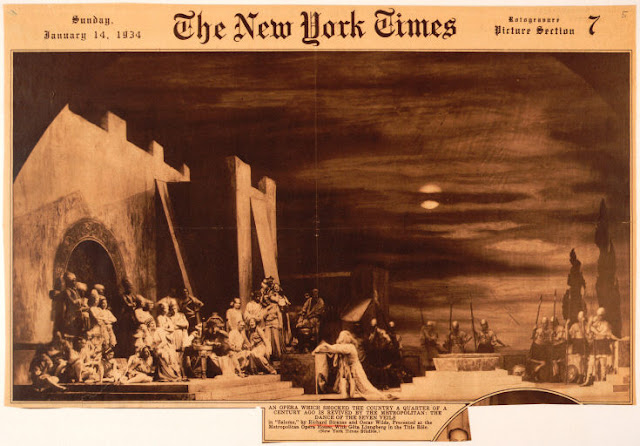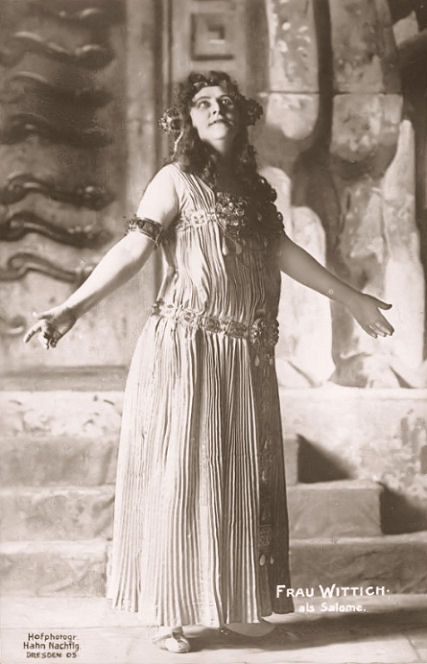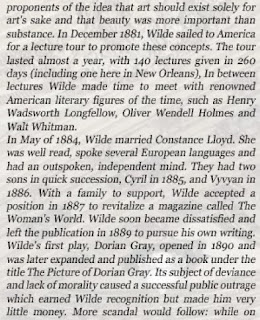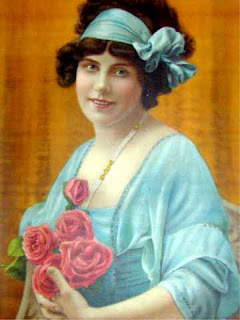"Among the artistic hierarchy, birds are probably
the greatest musicians to inhabit our planet .. "
AUTHOR: Oliver Messiaen
"From the very beginning man has
been imitating the music of birds. "
COMPOSER
RICHARD STRAUSS

RICHARD STRAUSS
 |
| Ludwig Hohlwein: Salome 1910 |
SALOME
(Complete)
Birgit Nilsson, Soprano as Salome
Georg Solti, Conductor
Vienna Philharmonic Orchestra


 |
| http://files.coc.ca/studyguides/salomestudyguide2013.pdf |
in one act), was composed to a German
libretto by the composer, based on
Hedwig Lachmann's German translation of the 1891
French play, Salomé, by Oscar Wilde
(his adaptation of Salome written in French).
SALOME...FOR SIMPLETONS
From: The Virginia Opera
 |
| http://www.cfa.arizona.edu/jpeterson/mus330b/Lecture29.html |
When the opera was premired
by the Dresden Opera in 1905
 |
| Premiere of Salome in Dresden in 1905 |
 |
| https://etd.ohiolink.edu/!etd.send_file?accession=bgsu1292720996&disposition=inline |
it helped usher in an era of musical avant-garde
modernism; a new unconventional art form which
was both condemned and passionately lauded
to the extreme by audiences. The singers
engaged for the first performance were horrified
at the demands on them by the score
but the opera, which received 38 curtain calls,
was an immediate success and cemented
Strauss's musical reputation. It is considered
by many to be among the most important
musical works of the 20th century.
| Salomé Dancing Before the Head of St. John the Baptist |
who attended the 1906 Austrian premiere
 |
Puccini, Zemlinsky, and Schoenberg,



Left to Right: Puccini, Zemlinsky, Schoenberg
praised the piece as
"one of the greatest masterworks of our time."
The story and text of Wilde's Salome (and
the Strauss opera), which features the
salacious "Dance of the Seven Veils"
the Strauss opera), which features the
salacious "Dance of the Seven Veils"
 |
| Paul Antoine de la Boulaye (French, 1849-1926) : Salomé (1909) |
BEHIND JOCHANAAN
(JOHN THE BAPTIST)
Greer Grimsley on his part in Salome
From: The San Francisco Opera
was very shocking, controversial, and broadly
rejected by many of the public at first because
of the "immorality" of its content and a tonal
sound that seemed to them depraved. It was
banned for years in the U.S. (where it had caused
 |
| Olive Fremstad Singing Salome at the Met Premiere |
and withdrawn after only
one performance) and elsewhere.
 |
| http://www.therestisnoise.com/2007/01/chapter-1-the-g.html |
It took several decades for this opera to gain the
of its power to shock, and its glittering
decadence quietly comes up fresh.


 |
| http://www.neworleansonline.com/pr/releases/releases/New%20Orleans%20Ballet%20Presents%20Salome.pdf |

Salomé, the opera, is known as much for its
revolutionary use of a large-scale orchestra,
pushing the boundaries of tonality
revolutionary use of a large-scale orchestra,
pushing the boundaries of tonality
(foreshadowing Stravinsky's Rite of Spring
one of the most demanding soprano roles with
respect to both vocal range and dramatic force)
as it is for its graphic depiction of this
deeply psychological and troubling tale.
respect to both vocal range and dramatic force)
as it is for its graphic depiction of this
deeply psychological and troubling tale.
According to Strauss, the formal structure of
Wilde's play was well-suited for musical
because adaptation. As Wilde himself
described it, Salomé contains choruses
which have recurring motifs making it
so like a piece of music when binding
them together as a ballad.
Wilde's play was well-suited for musical
because adaptation. As Wilde himself
described it, Salomé contains choruses
which have recurring motifs making it
so like a piece of music when binding
them together as a ballad.
| The leitmotif associated with Salome herself in Richard Strauss's opera Salome. (A leitmotif /ˌlaɪtmoʊˈtiːf/ is a "Short, constantly recurring musical phrase " [1] or motive associated with a particular person, place, or idea.) |
Each of the principal roles are given parts
to sing in a musical style revealing
to sing in a musical style revealing
aspects of his or her character.
 |
| Vardges Sureniants: Salome, 1907 |
Salome, is supported by a delicate orchestration
favoring high-pitched instruments: such as flutes,
violins , and celesta. Toward the end of the opera,
as the story comes to a climax, the orchestra
accompanies Salome's final monologue
with all its full range, dynamic, and timbral
capabilities. Jochanaan's (John the Baptist's)
music is devoutly tonal, generally favoring
flat key areas including A-flat major, the key Strauss
uses to symbolize religion (his system of "tonal
symbolism") and through which illustrates
Lokanaan's steadfast piety. Whole-tone scales, with
dissonant tritones at their structural core, create
a disorienting feeling showcasing the
personality of the perverse Herod.
Strauss gives extended solo passages to unusual
instruments, and combines groups of instruments in
novel and evocative ways. An example of this is the
combination of two harps playing harmonics combined
with celesta, cymbals, and hushed woodwinds to depict
Herod's demented state after the conclusion of the
"Dance of the Seven Veils." The clarinet's opening
ascending motive or leitmotif (associated with Salome)
continually interweaves throughout the opera and it is
featured prominently in Salome's famous dance.

SALOME
(Complete)
Maria Ewing, Soprano as Salome
(With English Subtitles)
Edward Downes, Conductor
King Herod begs Salome (his step-daughter) to dance
for him. Having been rejected by her twice before, he
provides incentive to her; the granting of any one
wish as long as she wants to dance for him. Piqued
by his generous offer and when satisfied he will
do as she wishes, she begins the seductive
"Dance of the Seven Veils"
for him. Having been rejected by her twice before, he
provides incentive to her; the granting of any one
wish as long as she wants to dance for him. Piqued
by his generous offer and when satisfied he will
do as she wishes, she begins the seductive
"Dance of the Seven Veils"
Aleksandra Ekster: Costume Design for Dance of the Seven Veils
Chamber Theatre's 1917 Production of Salome by Oscar Wilde
where she slowly removes eachof the seven veils she is wearing until she lies
naked at her stepfather's feet (this is not
stated specifically but suggested).
with a somewhat matronly figure,
trying to play a 16 year old. She
trying to play a 16 year old. She
vehemently refused to perform the
(or to kiss the severed
head of John the Baptist )
 |
| Nicholas Roerich: Salome with the Head of St John the Baptist |
saying in her often-quoted remark to Strauss,
"I will not do it; I'm a decent woman."
This created a situation where
A dancer had to stand in for her.
"I will not do it; I'm a decent woman."
This created a situation where
A dancer had to stand in for her.
 |
| Salome (Wittich ) on left and Strauss on far right (Dresden, 1905) |
SALOME
Dance of the Seven Veils
| Armand Point: Dance of the Seven Veils http://en.wikipedia.org/wiki/Dance_of_the_Seven_Veils #mediaviewer/File:PointArmandDanceOftheSevenVeils.jpg |
 |
| Robert Fowler: The Dance of Salome |
"Closing Theme"
Salome's wish is to immediately ask for
the head of Jochanaan (John the Baptist)
to be delivered to her on a silver platter.
King Herod trys to persuade her to change
her mind by offering other things but
Salome holds steadfast to her wish and
the King grants her it as promised.
Moments later, the king's guards return with
the Prophet's severed head delivered on a
silver platter as she requested.
the head of Jochanaan (John the Baptist)
to be delivered to her on a silver platter.
 |
| "Give me his head on a silver platter." |
her mind by offering other things but
Salome holds steadfast to her wish and
the King grants her it as promised.
Moments later, the king's guards return with
the Prophet's severed head delivered on a
silver platter as she requested.
Overjoyed, Salome grabs the head as if
Lokanaan were still alive and speaking
passionately to it proceeds to kiss his lips.
Disgusted by Salome's actions, King
Herod orders his guards to execute her.
Lokanaan were still alive and speaking
passionately to it proceeds to kiss his lips.
 |
| Lucien Levy-Dhurmer: Salome, 1896 |
Herod orders his guards to execute her.



https://mega.co.nz/#!DYoTmTIa!aHndGlu9vQ
-brMRRUDdI5Xv7VCIYGSpznpGLIiy0C-w

SALOME
Closing Theme
Ljuba Welitsch, Soprano as Salome
Role Debut, 1957
| Montserrat Caballe as Salome |
SALOME
Closing Theme
Montserrat Caballe, Soprano as Salome
Silvio Varviso, Conductor
https : //www.youtube.com/watch v = hTpjbehUiHY?
 |
| https://betweenthecoversblog.wordpress.com/2012/03/15/who-is-anne-marie/ |
IN THE ROLE OF SALOME:
Having composed the opera in German,
the version that it has become
widely known in, it has also has a
history of being presented in French.
The world's most famous proponent of
the role, soprano Mary Garden,
the version that it has become
widely known in, it has also has a
history of being presented in French.
The world's most famous proponent of
the role, soprano Mary Garden,


Paris, and other cities.



In the 1930's soprano


In the 1930's soprano
Marjorie Lawrence
SALOME
Final Scene
Marjorie Lawrence, Soprano as Salome

Marjorie Lawrence as Salome
sang the role in both French (for Paris)
and German (Hanes Metropolitan Opera,
New York) after Strauss made an alternate
version in French (the language of the
and German (Hanes Metropolitan Opera,
New York) after Strauss made an alternate
version in French (the language of the
OSCAR WILDE and "SALOME"
 |
| Oscar Wilde by Henri de Toulouse-Lautrec |
 |
| http://www.manitobaopera.mb.ca/cms-assets/documents/37438-883805.salome-study-guide2.pdf |

SALOME STORY
 |
| Romanesque Fresco: Müstair, Romanesque Frescoes in the St. Johann Monastery, c. 1160's |
 |
| Salome Bayerische Staatsbibliothek, Clm 835, f. 137 Psalter (Munich Golden Psalter) England [Gloucester], 1st quarter of the 13th century |
 |
| Salome Dancing for the Head of John the Baptist, 1323 |
 |
Herod Antipas with the Head of John the Baptist in Salome
Stained Glass, Saint Severin Church (Paris, France)
|
 |
| John The Baptist Window: Salome Dancing Before Herod Chartres, Saint-Pierre Church |
 |
| Photos de Vitraux: La Dance de Salomé |
It was revived in the Nineteenth Century
by various authors, but when Oscar
Wilde wrote his version of Salomé, in
1894, it took the world by storm.
 |
| Georges Desvallières: Salome, 1905 |
 |
| Lotte Nicklass: Salome, 1915 |
 |
| Salome, 1923 |
Wilde was Influenced by JC Heywood's
Moreau's paintings in Joris-Karl Huysmans'
À Rebours, which portrayed Salome as
the epitome of female depravity.
Gustave Moreau: Salome Dancing Before Herod
Salome Dancing, known as Salome Tattooed
| Gustave Moreau: The Apparition |
| Gustave Moreau: Salome (detail) http://en.wikipedia.org/wiki/Salome_%28play%29 |
Wilde wrote Salomé in French in 1891 but the
play was not produced for five years. In 1892
rehearsals for the play's first production were
planned, but halted when a British government
official in charge of theater censorship,
banned it because of an old law forbidding the
depiction of Biblical characters on stage.
play was not produced for five years. In 1892
rehearsals for the play's first production were
planned, but halted when a British government
official in charge of theater censorship,
banned it because of an old law forbidding the
depiction of Biblical characters on stage.
 |
| Relief depicting the Life of John the Baptist Amiens Cathedral, c.1531 |
In 1893 the play, written in French, was published
simultaneously in both France and England with
drawings by the artist Aubrey Beardsley,
| Oscar Wilde drawn by Aubrey Beardsley |


Aubrey Beardsley
and the discoveries being made in
the Egyptian tombs all contributed
to the many trends attributed to
fashions, paintings, and the
photographic postcards at
the turn of the century.
the Egyptian tombs all contributed
to the many trends attributed to
fashions, paintings, and the
photographic postcards at
the turn of the century.
| Beardsley, Aubrey (1872-1898) and Wilde, Oscar (1854-1900), The Climax, Important Original Illustration for Salome: A Tragedy in One Act, Published in 1894 |
in her "Dance of the Seven Veils"


Wilde's version of the story has spawned several other
artistic works with the most famous being Richard
Strauss's opera. Strauss had seen Wilde's
play in Berlin, in November 1902, at
Max Reinhardt's
artistic works with the most famous being Richard
Strauss's opera. Strauss had seen Wilde's
play in Berlin, in November 1902, at
Max Reinhardt's
 |
| Max Reinhardt |
'Little Theatre' with Gertrud Eysoldt
.jpg)

in the title role and was so
taken with it he began
to immediately compose
his opera Salome in the summer
of 1903. Strauss saw the play
performed using Hedwig Lachmann's
German translation version
taken with it he began
to immediately compose
his opera Salome in the summer
of 1903. Strauss saw the play
performed using Hedwig Lachmann's
German translation version
| Hedwig Lachmann 1865-1918 |
and used it as the basis of his
composition, moving the center of interest
to Salome, away from Herod Antipas
 |
| James Tissot: Herod (Hérode) |
(as in Wilde's version),
completing it in 1905 and premiering
the opera later the same year
The Strauss opera was not the
only operatic treatment from Wilde's
play as Antoine Mariotte wrote
a Salomé in 1905. He was involved
in a debate with Strauss to prove
his music was written earlier than Strauss's
version. Mariotte's version premiered in 1908.
SALOME
by Antoine Mariotte
Another musical retelling of the this story,
based on the 1877 novella Hérodias,
based on the 1877 novella Hérodias,
 |
| http://archive.org/stream/herodias00flau#page/n7/mode/2up |
 |
| Gustave Flaubert |
is Hérodiade,
 |
| http://www.artlyriquefr.fr/oeuvres/Herodiade.html |
HERODIADE
By Jules Massenet
Montserrat Caballé and
Josep Carreras, Vocalists
an opera in four acts by Jules Massenet
and Henri Grémont
(Georges Hartmann).
It was first performed
at the Théâtre de la Monnaie
in Brussels on 19 December 1881 and
although it tells the story of John the Baptist,
Salome, Herod Antipas and Herodias, it is
strikingly less psychological and bloody
than Richard Strauss's Salome.


Emma Calve in Hérodiade
 |
| Emma Calve |
The phenomenon of "Salomania" (a term coined by
newspaper reporters in the early twentiest
century to explain the outburst of
Salome interpretations)


in the arts including popular music,


newspaper reporters in the early twentiest
century to explain the outburst of
Salome interpretations)


Even products sold contained "Salomania."
started to be displayed through other stylesin the arts including popular music,



SAL-O-MAY
By Robert Stolz
 |
| http://sadiesalome.com/about.html?KeepThis=true |
SADIE SALOME GO HOME
By Irving Berlin



SALOME
By William Loraine



VISION OF SALOME
By Archibald Joyce


film, and dance.
OTHER VERSIONS
OF THE SALOME STORY
SALOME
1923 Silent Movie
(Biography/Documentary)

OSCAR WILDE
A&E Biography (1)
OSCAR WILDE
A&E Biography (2)
OSCAR WILDE
A&E Biography (3)
OSCAR WILDE
A&E Biography (4)
OSCAR WILDE
A&E Biography (5)
OSCAR WILDE
A&E Biography (6)
OSCAR WILDE
A&E Biography (7)


SALOME 1923
MORE FILMS ABOUT SALOME
SALOME
With Rita Hayworth
| http://www.johncoulthart.com/feuilleton/2011/05/31/wild-salomes/ |
 |
| Rita Hayworth as Salome |
SALOME
1953 Trailer
Rita Hayworth
SALOME
With Theda Bara


WILDE SALOME
With Jessica Chastain and Al Pacino
 |
| http://www.imdb.com/title/tt0795459/ |
WILDE SALOME
Promo Video with Al Pacino
SOME OTHER FAMOUS SOPRANOS
IN THE ROLE OF SALOME:
(Left) Jacques Carlu: Geneviève Vix as Salomé (1920)
The "Dance of the Seven Veils" (when using Strauss's
version of the music) was often detached from the
rest of his piece and performed separately as it was the
only section of this composition that was self-contained
with its own internal musical structure.
Loie Fuller
 |
| Georges de Feure: Loie Fuller |
Loie Fuller performed a 1907 version of
Florent Schmitt's
 |
| Florent Schmitt, 1900 |
music, "The Tragedy of Salome."
 |
| Tragedie of Salome |
 |
| Loie Fuller |
Tamara Karsavina was an Anglo-Russian ballerina
whose partnership with Vaslav Nijinsky
 |
| Tamara Karsavina (1885-1978) and Vaslav Nijinsky (1888-1950) in Giselle |
 |
| Tamara Karsavina: Autochrome by Baron de Meyer, c.1908 |
 |
|
(Portrait of Tamara Karsavina as Salome in the Ballet
"The Tragedy of Salome" by Florent Schmitt), 1914
|
 |
| La Tragédie de Salomé 28th June, 1913: Tamara Karsavina as Salome at Drury Lane, London Music by Florent Schmitt Based on Aubrey Beardsley Illustrations |



Costume by Sudeykin for Tamara Karsavina in Salomé
Maud Allan
Maud Allan (Canadian-born dancer)
 |
Maud Allan
|
successfully toured Europe with her show
"The Vision of Salome" in it dancing
to an arrangement of Strauss's music by
Belgian musician and critic Marcel Remy.
 |
| R. Trinidad: Exotic Dancer Maud Allan Portrays Salome, c.1909 |
MORE SALOME IN ART
 |
| Alphonse Mucha: Salomé, 1897 |
 |
| Francis Luis Mora: Salome (1899) |
| Lucas Cranach the Elder: Salome with the Head of St John the Baptist http://en.wahooart.com/A55A04/w.nsf/Opra/BRUE-8CABSU |
| Lucas Cranach the Elder: Salome, c.1530 |
 |
| Lucas Cranach: The Feast of Herod, 1533 |
| Andrea Solari : Salome Receives the Head of St. John the Baptist, 1506-7 |
 |
| Gian Francesco Barbieri (1591-1666): Salome |
| Caravaggio: Salome With The Head, 1607 |
 |
| Michelangelo Merisi da Caravaggio: Salome with the Head of the Baptist c.1609 |
| Masolino da Panicale: Salome before Herod, 1435 |
 |
| Erte: Salome |
http://www.britannica.com/EBchecked/topic/519575/Salome
http://www.therestisnoise.com/2007/01/chapter-1-the-g.html
http://www.manitobaopera.mb.ca/cms-assets/documents/37438-883805.salome-study-guide2.pdf
http://files.coc.ca/studyguides/salomestudyguide2013.pdf
http://www.neworleansonline.com/pr/releases/releases/New
%20Orleans%20Ballet%20Presents%20Salome.pdf

http://www.therestisnoise.com/2007/01/chapter-1-the-g.html
http://www.manitobaopera.mb.ca/cms-assets/documents/37438-883805.salome-study-guide2.pdf
http://files.coc.ca/studyguides/salomestudyguide2013.pdf
http://www.neworleansonline.com/pr/releases/releases/New
%20Orleans%20Ballet%20Presents%20Salome.pdf

http://www.smh.com.au/entertainment/music/a-to-z-of-german-composer-richard-strauss-20140529-zrrgb.html
http://www.theguardian.com/music/2008/feb/19/classicalmusicandopera.dance
https://archive.org/details/strausssalomegui00gilmuoft
http://files.coc.ca/studyguides/salomestudyguide2013.pdf
http://www.gbopera.it/2014/07/richard-strauss-celebrations-le-opere-salome/
http://www.johncoulthart.com/feuilleton/the-salome-archive
http://operastory.co.uk/richard-strauss-salome/
http://www.tabletopopera.com/#salome
https://etd.ohiolink.edu/!etd.send_file?accession=bgsu1292720996&disposition=inline
http://www.theguardian.com/music/2008/feb/19/classicalmusicandopera.dance
https://archive.org/details/strausssalomegui00gilmuoft
http://files.coc.ca/studyguides/salomestudyguide2013.pdf
http://www.gbopera.it/2014/07/richard-strauss-celebrations-le-opere-salome/
http://www.johncoulthart.com/feuilleton/the-salome-archive
http://operastory.co.uk/richard-strauss-salome/
http://www.tabletopopera.com/#salome
https://etd.ohiolink.edu/!etd.send_file?accession=bgsu1292720996&disposition=inline
MORE ART ON THE
| Jules Pascin: Salome |
| Sandro Botticelli: Salome with the Head of St John the Baptist, c.1488 |
 |
| Guido Reni |
 |
| Guido Reni: Salomé |
| Edvard Munch: Salome Paraphrase |
 |
| Giampietrino: Salome, c.1510-30 |
| http://historiesofthingstocome.blogspot.com/2011/09/history-of-colour-red.html |
 |
| Barnardo Strozzi: Salome |
 |
| Bernardino Luini: Salome with the Head of John the Baptist |
 |
| Bernardo Martorell: Salome |
 |
| Carlo Dolci: Salome with Head of St. John the Baptist |
 |
| Domenico Ghirlandaio: Salome |
 |
| David Teniers Jr: Feast of Herod |
 |
| Fra Filippo Lippi: Salome |
Salome Dancing at the Feast of Herod
(Details from the Fresco)
 |
| Paul Delaroche: Herodias and Salome Holding the Head of John the Baptist in a Bronze Vase |
 |
| Giovanni Battista Tiepolo: Salome |
 |
| Girolamo Romanino |
 |
| Onorio Marinari: Herodias and Salome with the Head of John the Baptist |
 |
| Juan de Flandes: Herodias' Revenge, 1496 |
 |
| Jacinta Gil Roncales: Salome |
 |
| Jacob Cornelisz van Oostsanen |
 |
| Jan Adam Kruseman |
 |
| Jean Jacques Henner: Salome |
 |
| Josef Wenig: Salome, 1907 |
 |
| Lucas van Leyden |
Juan Flamenco:
Decapitation of St. John Baptist
Prado, Madrid 15th Century
Decapitation of St. John Baptist
Prado, Madrid 15th Century
 |
| Maurycy Gottlieb |
 |
| Maurycy Gottlieb: Salome's Dance |
 |
| Quentin Massys: Salome |


Rogier van der Weyden
 |
| Georges Antoine Rochegrosse: Salome |
 |
| Tiziano Vecellio (Titian): Salome, c.1515 |
 |
| Henri Regnault: Salomé, 1870 |
 |
| Federico Ribas: Salomé, 1918 |
 |
| Marcus Behmer: Salome |
 |
| G.Vereschagin |
 |
| Henri Léopold Levy: Hérodiade, 1872 |
 |
| Frank Schmitz: The Dance of Salome |
 |
| Raphael Kirchner, 1916 |
 |
| Vania Zouravliov: Salome |
 |
| Unknown Flemish: Salome |
 |
| http://www.yessy.com/suzhouembroidery/gallery.html?i=6900 |
 |
| Benozzo Gozzoli: The Feast of Herod and the Beheading of Saint John the Baptist |
 |
| Guidoccio Cozzarelli: Dance of Salome, 1516 |
 |
| Salome with the Head of John the Baptist |
 |
| Egidio Manganelli |
 |
| Salome with the Head of Johannes |
 |
| Willem Arondeus: Salome, 1916 |
 |
| Ezio Anichini: Salomé |
SALOME LESSON IDEAS
 |
| https://www.cartoonstock.com/directory/s/salome.asp |









 |
| https://www.cartoonstock.com/directory/s/salome.asp |




















































































